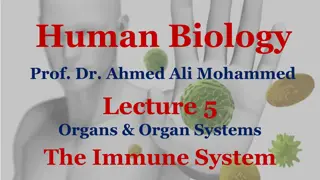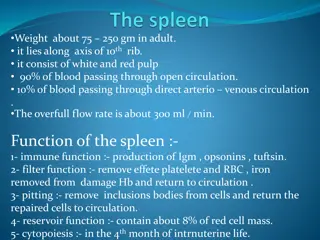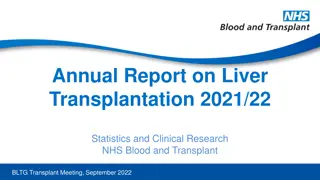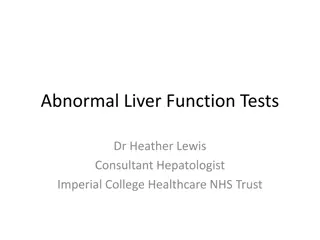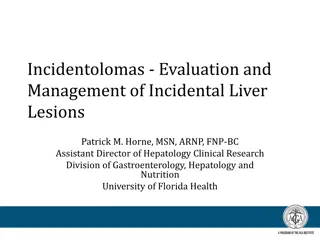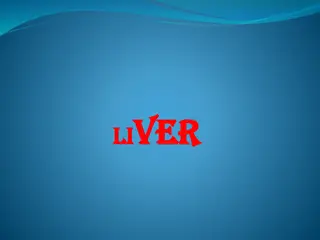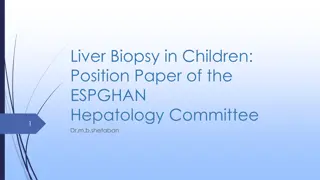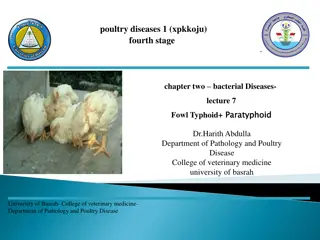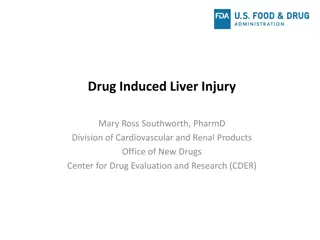Histological Structure of Liver and Spleen: Key Features and Functions
In this informative content, the histological structures of the liver and spleen are explored in detail. Key components such as hepatocytes, sinusoids, bile canaliculi, and the spaces of Disse in the liver, and the white pulp and red pulp in the spleen are highlighted. The classic liver lobule, central vein, portal areas, and contents of portal tracts are explained, along with the functions of hepatocytes and the space of Disse. The description touches on endothelial cells, Kupffer cells, fat-storing cells, and reticular fibers in liver sinusoids. The focus is on providing a comprehensive understanding of the microscopic anatomy of these vital organs.
Download Presentation

Please find below an Image/Link to download the presentation.
The content on the website is provided AS IS for your information and personal use only. It may not be sold, licensed, or shared on other websites without obtaining consent from the author. Download presentation by click this link. If you encounter any issues during the download, it is possible that the publisher has removed the file from their server.
E N D
Presentation Transcript
LIVER & SPLEEN Color index: Slides.. Important ..Notes ..Extra..
Objectives: Objectives: By the end of this lecture, the student should be able to describe: 1. The histological structure of liver with special emphasis on: Classical hepatic (liver) lobule. Hepatocytes. Portal tract (portal area). Hepatic (liver) blood sinusoids. Space of Disse (perisinusoidal space of Disse) Bile canalculi. 2. The histological structure of spleen with special emphasis on: White pulp. Red Pulp.
LIVER 1-Stroma; 2-Parenchyma; Classical liver (hepatic) lobules mainly C.T, but not in humans. It is formed of a polygonal mass of liver tissue, bounded by interlobular septa with portal areas at the periphery & central (centrolobular) vein in the center. Central vein: surrounded by hepatocytes a- Capsule: Glisson s Capsule. b- Septa (absent in human) & Portal areas (Portal tracts) Portal area: surrounded by other structures. c- Network of reticular fibers.
LIVER Contents of the Classic Liver Lobule: Contents of the Classic Liver Lobule: the rows of hepatocytes should be next to each other; remember canaliculi 1- Anastomosing plates of hepatocytes. 2- Liver blood sinusoids (hepatic blood sinusoids): between the plates. 3- Spaces of Disse (perisinusoidal spaces of Disse) between the hepatocytes and sinusoids 4- Central vein. 5- Bile canaliculi. Borders of the Classical Liver Lobule Borders of the Classical Liver Lobule Septa: C.T. septa (e.g. in pigs). Portal areas (Portal tracts): Are located in the corners of the classical hepatic lobule (usually 3 in No.). Contents of portal area: a- C.T. b- Bile ducts (interlobular bile ducts). c- Venule (Branch of portal vein). d- Arteriole (Branch of hepatic artery). Hepatic artery: surrounded by smooth muscles while the bile duct is not. 1- 2-
Hepatocytes (LM) IMPORTANT: *the hepatocytes have two surfaces: one facing another hepatocyte, the other facing the sinusoids *Are grouped in interconnected plates. *Liver sinusoids are located in the spaces between these plates. Shape: polyhedral Nucleus: 1 or 2, vesicular with prominent nucleoli. Cytoplasm: acidophilic. Organelles: 1- Mitochondria: ++++ 2- ER (sER & rER): abundant. 3- Golgi complex. 4- Lysosomes. 5- Peroxisomes. Inclusions (Deposits): 1- Glycogen 2- Lipid (few droplets). 3- Lipofuscin (old age) The area facing the hepatocyte has tight junctions which increase surface area and desmosomes to fix these junctions in place. The area facing the sinusoids have microvilli for absorption and secretion of metabolites to/from the hepatocytes, but these microvilli do not reach the blood.
Space of Disse (Perisinusoidal Space) Liver Blood Sinusoids (1) Endothelial Cells: (1) Endothelial Cells: Fenestrated & discontinuous free passage of plasma. Basal lamina is absent. (2) Kupffer Cells: (2) Kupffer Cells: produce lysosomes Are macrophages. Are found on the luminal surface of the endothelial cells. Function: phagocytosis. Contents: Contents: 1- Fat-storing cells (Ito cells) (Hepatic stellate cells): contain vitamin A-rich lipid. form reticulin. 2- Reticular fibers: formed by reticulin (type III collagen). Normally present in small amounts, an increase = liver fibrosis 3- Plasma of blood. NOT cells! , cells found in the blood are NOT filtered ! 4- Microvilli of hepatocytes.
Spleen Stroma of Spleen Parenchyma of Spleen 1- Capsule: Is covered by visceral layer of peritoneum; mesothelium. Is formed of fibromuscular C.T. (Dense fibrous C.T. + smooth muscle cells). Muscles for contraction in case of loss of blood 2- Trabeculae: Are irregular, incomplete, divide the spleen into intercommunicating compartments (lobules). 3- Reticular C.T. A. B. White pulp. Red pulp (around white pulp) N.B. to differentiate the spleen from the lymph nodes No cortex, No medulla, No afferent lymphatic vessel.
Parenchyma of Spleen Cells of parenchyma of Spleen (A) White Pulp (B) Red pulp 1. Lymphocytes B + T 2. Plasma cells. 3. Macrophages for the filtration of blood 4. Blood elements (RBCs, leucocytes and blood platelets). 1. Periarterial lymphatic sheaths (PALS): housing T lymphocytes. 2. Lymphoid follicles (with germinal centers): housing B lymphocytes. 1. Splenic (pulp) cords: Extravasated blood cells, plasma cells, macrophages & reticular cells and fibers. 2. Splenic blood sinusoids: Surrounded by the pulp Are lined with elongated fusiform endothelial cells with large intercellular spaces & supported by discontinuous, circular basement membrane. Splenic Microcirculation IMPORTANT: The PALS (blue area surrounding the artery) have T-Cells PURELY N.B. Both 1&2 have the acentrically located central artery (central arteriole) (follicular arteriole).
MCQs 1\ Glisson s Capsules are found in: A-parenchyma. B-stroma. C-Both A&B. 5\Fat-storing cells in liver are called: a.Endothelial cells. b.kupffer cells c.Ito cells. 6\ Which of the following is part of the spleen s Parenchyma? a. Cortex. b. Red Pulp. c. Medulla. 2\ the shape of hepatocyte is: a.polyhedral. b.spherical. c.spiral. 3\ What is the space between the liver sinusoids and the hepatocytes called? a. Space of Disse. b. Space of Mall. c. Vacuole. 7\one of The differences between the spleen and the lymph nodes is: a.spleen has no white pulp. b.Spleen has cortex. c.Spleen has No medulla. 4\what is the function of Kupffer Cells: a.Regeneration. b.Phagocytosis. c.nutrtion. 7-c 6-b 5-c 4-b 3-a 2-a 1-b
Thank you & good luck - Histology team Done by: Amal AlQarni Do aa AlWalid Heba AlNasser Shahad AlAnzan We am Babaier Team leaders: Rana Barasain Faisal Alrabaii References: References: Females and Males slides. Doctors notes Document








